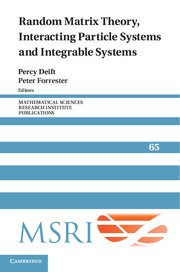Book contents
- Frontmatter
- Contents
- Preface
- Universality conjecture for all Airy, sine and Bessel kernels in the complex plane
- On a relationship between high rank cases and rank one cases of Hermitian random matrix models with external
- Riemann–Hilbert approach to the six-vertex model
- CLT for spectra of submatrices of Wigner random matrices, II: Stochastic evolution
- Critical asymptotic behavior for the Korteweg–de Vries equation and in random matrix theory
- On the asymptotics of a Toeplitz determinant with singularities
- Asymptotic analysis of the two-matrix model with a quartic potential
- Conservation laws of random matrix theory
- Asymptotics of spacing distributions 50 years later
- Applications of random matrix theory for sensor array imaging with measurement noise
- Convolution symmetries of integrable hierarchies, matrix models and τ-functions
- Universality limits via “old style” analysis
- Fluctuations and large deviations of some perturbed random matrices
- Three lectures on free probability
- Whittaker functions and relatedstochastic processes
- How long does it take to compute the eigenvalues of a random symmetric matrix?
- Exact solutions of the Kardar–Parisi–Zhang equation and weak universality for directed random polymers
- Replica analysis of the one-dimensional KPZ equation
- Asymptotic expansions for β matrix models and their applications to the universality conjecture
- KPZ scaling theory and the semidiscrete directed polymer model
- Experimental Realization Of Tracy–Widom Distributions And Beyond: Kpz Interfaces In Turbulent Liquid Crystal
- Random matrices: the four-moment theorem for Wigner ensembles
Preface
Published online by Cambridge University Press: 29 May 2025
- Frontmatter
- Contents
- Preface
- Universality conjecture for all Airy, sine and Bessel kernels in the complex plane
- On a relationship between high rank cases and rank one cases of Hermitian random matrix models with external
- Riemann–Hilbert approach to the six-vertex model
- CLT for spectra of submatrices of Wigner random matrices, II: Stochastic evolution
- Critical asymptotic behavior for the Korteweg–de Vries equation and in random matrix theory
- On the asymptotics of a Toeplitz determinant with singularities
- Asymptotic analysis of the two-matrix model with a quartic potential
- Conservation laws of random matrix theory
- Asymptotics of spacing distributions 50 years later
- Applications of random matrix theory for sensor array imaging with measurement noise
- Convolution symmetries of integrable hierarchies, matrix models and τ-functions
- Universality limits via “old style” analysis
- Fluctuations and large deviations of some perturbed random matrices
- Three lectures on free probability
- Whittaker functions and relatedstochastic processes
- How long does it take to compute the eigenvalues of a random symmetric matrix?
- Exact solutions of the Kardar–Parisi–Zhang equation and weak universality for directed random polymers
- Replica analysis of the one-dimensional KPZ equation
- Asymptotic expansions for β matrix models and their applications to the universality conjecture
- KPZ scaling theory and the semidiscrete directed polymer model
- Experimental Realization Of Tracy–Widom Distributions And Beyond: Kpz Interfaces In Turbulent Liquid Crystal
- Random matrices: the four-moment theorem for Wigner ensembles
Summary
In the spring of 1999, MSRI hosted a very successful and influential onesemester program on random matrix theory (RMT) and its applications. At the workshops during the semester, there was a sense of excitement as brand new and very recent results were reported. The goal of the 2010 Program has been to showcase the many remarkable developments that have taken place since 1999 and to spur further developments in RMT and related areas of interacting particle systems (IPS) and integrable systems (IS) as well as to highlight various applications of RMT.
One of the outputs of the 1999 program was volume 40 in the MSRI Publications series, entitled “Random matrix models and their applications”. Looking back on this publication today, it is clear that this volume gave a representative snapshot of topics that were occupying the attention of researchers in the field then. Moreover, the papers—consisting of a mix of research articles and reviews— provide a conveniently bundled resource for researchers in the field to this day.
Since 1999 random matrix theory has captured the imagine of a whole new generation of researchers, and through a collective effort some outstanding questions have been settled, and new highly promising research areas initiated. One example of the former is work on universality questions forWigner matrices, where the task is to show that for large dimension a symmetric matrix with independent entries of mean zero and standard deviation 1 has the same statistical properties as in the case of standard Gaussian entries. Another is universality questions for β-ensembles, where one wants to show that the statistical properties are independent of the one-body potential. New research areas include the KPZ equation and related growth processes, which has led to the precise experimental realization of some random matrix distributions, and also to quite spectacular theoretical advances relating to a rigorous understanding of the replica trick via so called Mcdonald processes; analytic predictions of the -generalization of the so-called Dyson constant in the asymptotic expansion of spacing distributions inβ-ensembles; and stochastic differential equations and PDEs for eigenvalue distributions in the case of a low rank perturbation leading to eigenvalue separation.
Information
- Type
- Chapter
- Information
- Publisher: Cambridge University PressPrint publication year: 2014
